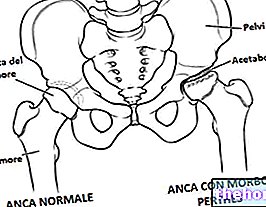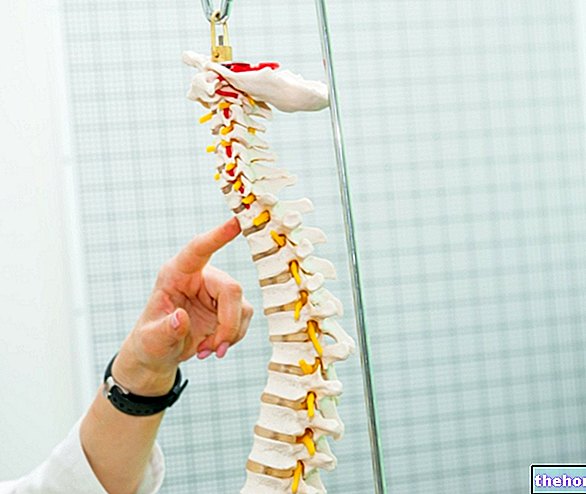Generality
Paget's disease is a metabolic bone disease, also known as osteitis deformans or Paget's disease of bone.The pathology involves an alteration of bone remodeling, which occurs with an exaggerated and disordered rhythm, undermining the structural integrity of the skeleton and predisposing to fractures and bone malformations.
Bone renewal (or remodeling) is a metabolic process of destruction and regrowth of the bone, aimed at its continuous renewal, therefore at maintaining its functional and structural integrity.

What is Paget's disease
Bone is a metabolically active tissue. The dynamic nature of bone structures is evident, not only during the age of growth, but also in their ability to adapt their structure in response to external forces and to repair themselves after a fracture.
The restructuring of the bone is called remodeling and occurs thanks to the presence of two different types of cells, located on the external surface and in the cavities of the bone structures. Osteoblasts ("bone producers") are responsible for building bone mass through a process of deposition, while osteoclasts ("bone breakers") are responsible for the demolition of bone tissue through a process called resorption. When the activity of the osteoblasts exceeds that of the osteoclasts, bone growth occurs, vice versa when the osteoclasts prevail, a reduction in bone mass is obtained.
In patients with Paget's disease, the normal bone turnover process is disrupted. The dynamic balance present between osteoblasts and osteoclasts is in fact lacking: the demolition of the bone tissue occurs very quickly and is followed by an abnormal growth, where the bone structure is disorganized and deformed. Initially, there is a marked increase in bone resorption in localized areas, due to the activity of numerous osteoclasts. Osteolysis is followed by a compensatory increase in the new bone formation, induced by the osteoblasts recruited in the area. The intense and accelerated osteoblastic activity produces a coarse tissue, formed by thick lamellae and trabeculae that are arranged in a chaotic manner ("mosaic" model. ), instead of respecting the normal lamellar model. The resorbed bone tissue is replaced and the medullary spaces are filled with an excess of fibrous connective tissue, with a marked increase in new blood vessels (hypervascularization of the newly formed bone). Bone hypercellularity can, therefore, cause malignant degeneration (bone pagetic).
The pathological alteration of the bone resorption and neoformation cycle makes the new bone larger and softer, therefore fragile and subject to fractures. Paget's disease is typically localized and as such affects only one or a few bones, on the contrary, for example, of osteoporosis (generalized bone disease). The disease most commonly affects the bones of the pelvis, skull, spine and legs. Possible complications depend on the affected bone segment and can include bone fractures, osteoarthritis, hearing loss and compression of nerve structures due to increased volume of the involved bones.
The risk of Paget's disease onset is related to "increasing age": the disease is rarely diagnosed in people under the age of 40. In addition, some hereditary genetic factors appear to influence disease susceptibility and men are more affected than women (3: 2). Paget's disease of bone occurs worldwide but is more common in Europe, Australia, and New Zealand. Worldwide, the UK has the highest prevalence.
While there is no cure for Paget's disease, some medications can help control the disease and reduce pain and other symptoms. In particular, bisphosphonates, also used to strengthen bones weakened by osteoporosis, represent the cornerstone of therapy. In severe cases, it may be necessary to resort to a surgical procedure. Currently, early diagnosis and drug therapy, especially if applied before complications arise, they are measures that allow you to effectively control the disease.
Causes
The cause of Paget's disease of bone is still unknown, although it is not excluded that the genesis of the disease may be multifactorial. Paget's disease can be sporadic or familial.
The etiological hypotheses currently most accredited are two:
- Some genes appear to be linked to the disorder. Considering the evident familiarity in numerous affected subjects, the cause of Paget's disease could have to do with the expression of some genes, transmitted as an autosomal dominant trait. The most frequently encountered genetic alterations involve the expression of RANK (Receptor Activator of Nuclear Factor k B, which activates osteoclasts and initiates their differentiation) and the Sequestosome1 gene (SQSTM1), which encodes the p62 protein, involved, together to ubiquitin and other cytoplasmic proteins, in modulating the function of the nuclear growth factor NFkB, important for the recruitment of pre-osteoclasts and the activation of the osteoclasts themselves.
- Viral infection. A slow-replicating virus would localize to the bone cells many years before symptoms appear. This infecting agent could attack osteoclasts and induce a hyper-reactive response to activating factors, such as vitamin D and RANKL (ie the RANK receptor ligand). Pathologist James Paget, who first provided a precise description of the disease (hence the name), also suggested that the disease was potentially due to an inflammatory process. Recent data support this etiological hypothesis and suggest that the cause of Paget's disease could be due to a paramyxovirus infection. However, no infectious virus has yet been isolated from the affected tissues and identified as a causative agent, so this hypothesis remains to be confirmed. .
Symptoms
For further information: Paget's disease symptoms
Many patients are unaware that they have Paget's disease, as the disorder can be subtle, asymptomatic, or with mild symptoms. In many cases, the diagnosis is made accidentally or only after complications arise. When symptoms occur, bone pain is the most common complaint. The disease can affect individual bones (for example: skull, tibia, ileus, femur , humerus and vertebrae) or spread to multiple areas of the body.In some cases, the skin temperature may rise in areas where the disease is active.
Common symptoms of Paget's disease can include:
- Bone pain and joint stiffness (pain can be severe and present most of the time)
- Numbness, tingling and weakness
- Bone deformities: enlargement of the affected segments and other visible deformities, such as those affecting the skull (frontal bulges, enlarged jaw or increased head size).
Other less common signs will depend on which part of the body is affected, including:
- Loss of hearing and tinnitus (due to compression of the VIII cranial vestibulocochlear nerve).
- Vertigo and headache, due to the overgrowth of the bones of the skull;
- Pain or numbness along the course of a nerve if the spine is affected and a spinal nerve root is pinched (radiculopathy);
- Long bone inclination
- Spinal stenosis (narrowing and compression of the spinal cord and nerves).
In most cases, Paget's disease of bone progresses slowly and can be managed effectively in almost any person.
Paget's disease, especially if neglected, can induce other medical conditions, including:
- Complete bone fractures or fissures of the cortical bone. Pathological breaks can produce profuse blood loss due to the typical hypervascularization of the pagetic bone.
- Osteoarthritis and secondary osteoarthritis: deformed bones can increase the amount of stress on the joints adjacent to the bone affected by the disease. For example, arthritis can be caused by the bowing of the long bones of the legs, distorting their alignment and increasing pressure. on nearby joints (knee, hip and ankle). In addition, pagetic bone can increase in size, causing wear of the articular cartilages and tearing of the knee or hip. In these cases, the pain may be due to a combination of Paget's disease and osteoarthritis.
- Osteosarcoma (malignant bone tumor): neoplastic transformation is a very rare occurrence, described in the most severe forms, which should be considered when pain arises or worsens suddenly and sensibly.
- Deafness in one or both ears can occur when Paget's disease of the bone affects the skull and the bone surrounding the inner ear. Treatment can slow or stop hearing loss, and hearing aids can support this condition.
- Some cardiovascular diseases can result from severe Paget's disease (with more than 15% skeletal involvement). Arteriovenous connections can often form in the bone, so the heart must increase its workload (ie pump more blood) to ensure adequate oxygen supply to the tissues. This increase in cardiac output can lead to calcification of the aortic valve. The resulting aortic stenosis can cause "ventricular hypertrophy and potentially lead to" heart failure.
- Other neurological complications: nerve compression syndromes and cauda equina syndrome. If the affected site is the skull base, cranial nerve palsy can occur, while if Paget's disease affects the spine, paraplegia with functional deficiency or motor paralysis can occur. Rarely, when the skull is involved, there may be involvement of the oculomotor nerves, with consequent visual field disturbances.
Paget's disease is not related to osteoporosis: although Paget's disease of bone and osteoporosis can occur in the same patient, they are different disorders. Despite their marked differences, several treatments for Paget's disease are also used effectively for the treatment of osteoporosis.
Diagnosis
The diagnosis of Paget's disease can derive from the investigation of specific suspicious clinical signs or be completely random.
Bone disease can be diagnosed using one or more of the following investigations:




























